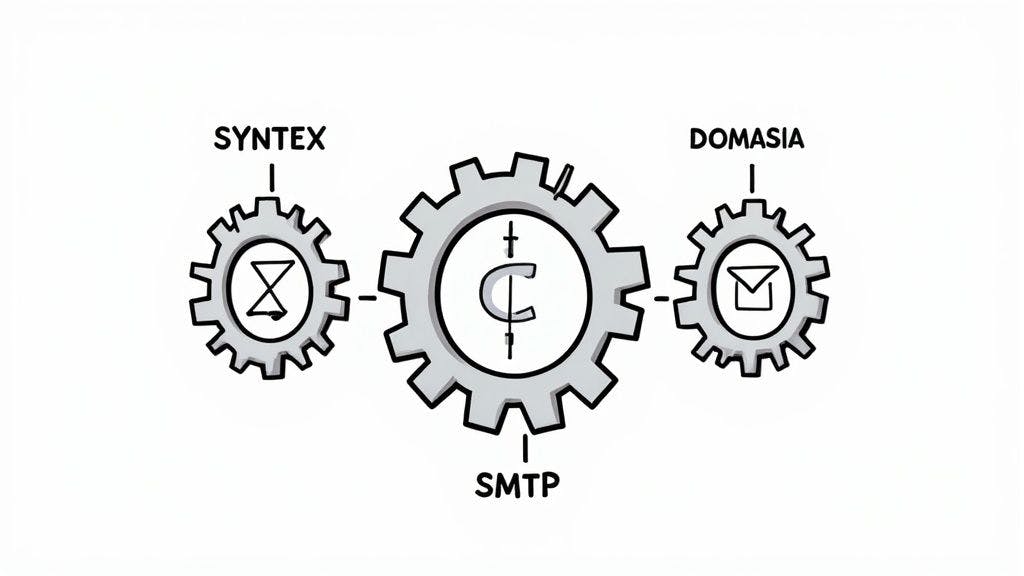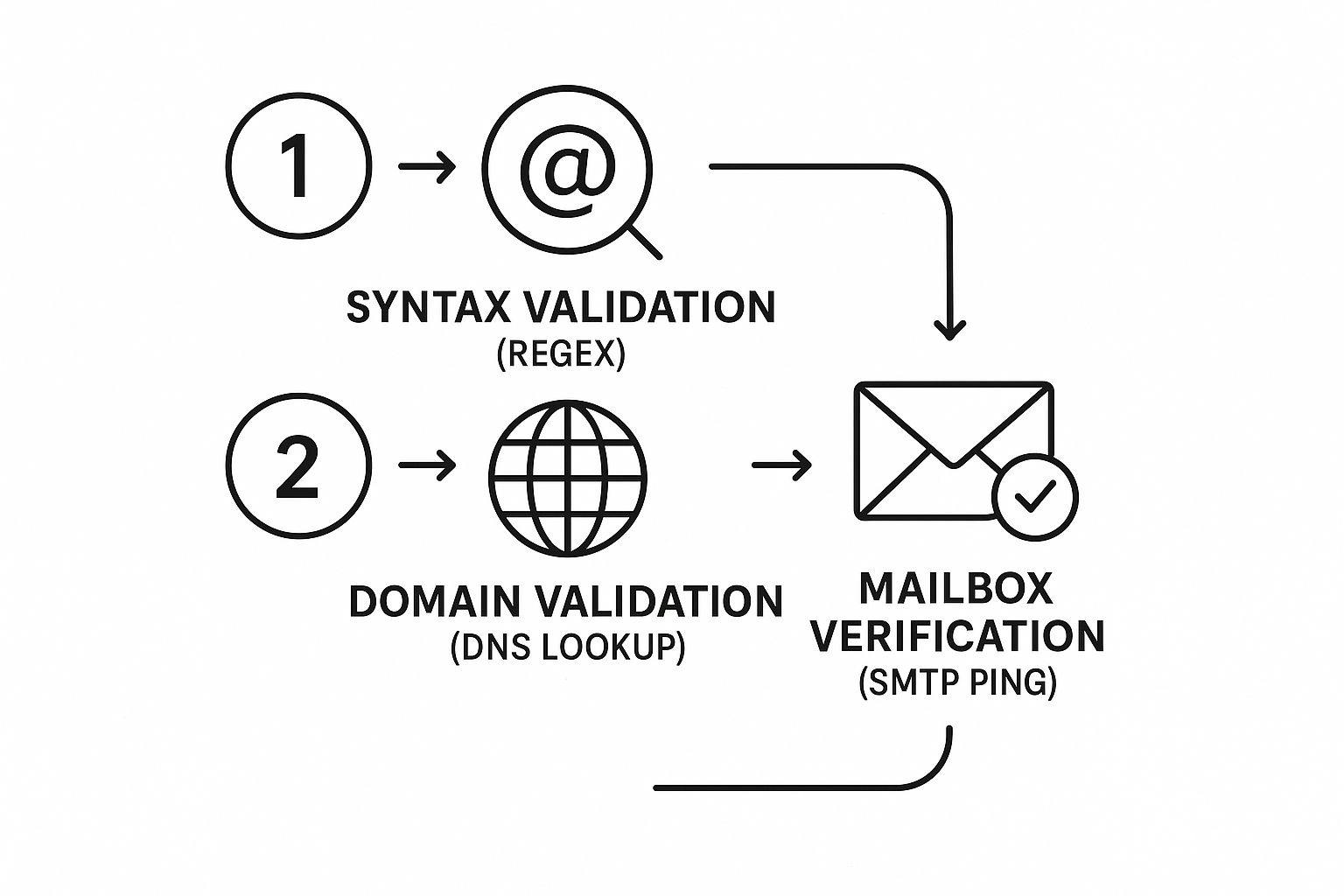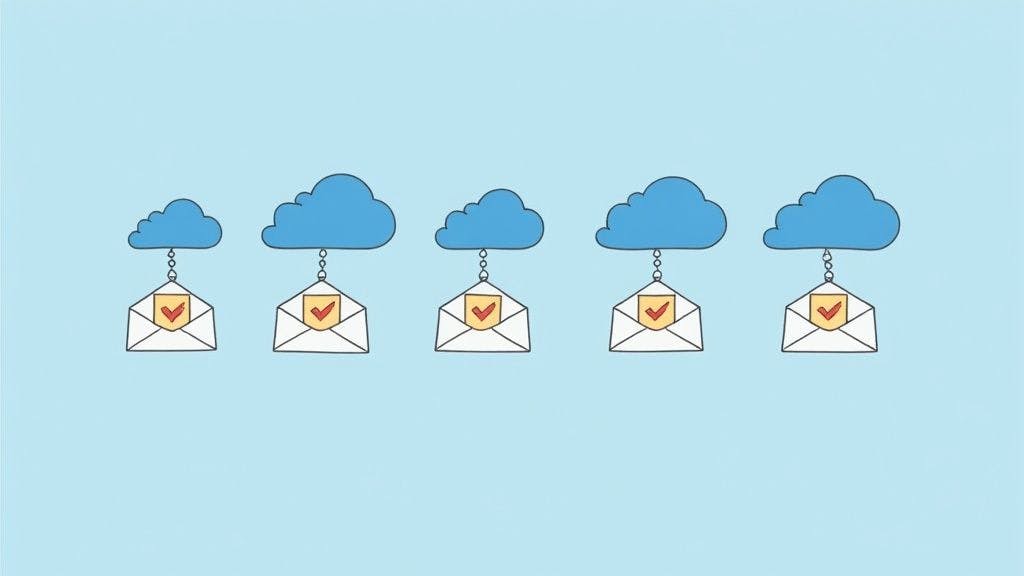Ever heard the saying, "The money is in the list"? Well, that's only half the story. The real value is in a clean list. That's where email validation comes in.
It’s the process of checking if an email address is valid, deliverable, and actually belongs to a real person before you ever hit "send." Think of it as your first line of defense against high bounce rates, a tarnished sender reputation, and marketing dollars going straight down the drain.
Why You Can't Afford to Skip Email Validation

Just collecting emails without validating them is like building a house on a shaky foundation. Sooner or later, it’s going to cause problems. Unverified addresses aren't just dead ends; they're active liabilities that can seriously sabotage your marketing efforts.
Every single bounced email sends a bad signal to Internet Service Providers (ISPs) like Gmail and Outlook. Once your bounce rate creeps over the 2% threshold, they start to see you as a sloppy sender. The result? Your carefully crafted messages get diverted to the spam folder or, even worse, blocked entirely.
The Real-World Costs of a Dirty List
Ignoring email list hygiene has direct financial consequences. You pay your email service provider for every contact on your list, whether they're real or not. Sending campaigns to invalid addresses means you're literally paying to talk to nobody. That's a direct hit to your ROI.
The scale of email is massive. By 2025, it's projected that 4.6 billion people will use email, firing off about 376.4 billion emails every single day. With that kind of volume, protecting your sender reputation from bounces and spam complaints isn't just good practice—it's critical for survival.
A clean email list isn't just a "nice-to-have." It's the bedrock of effective digital communication. It gives your message the best possible chance of being seen, which is the first, most crucial step toward any conversion.
Ultimately, the main goal here is to significantly improve email deliverability, ensuring your hard work actually lands in the inbox.
Understanding the Different Layers of Validation
Good email validation isn't a one-and-done deal. It’s more like a series of checkpoints, with each one giving you more confidence in the quality of an address.
To give you a clearer picture, here’s a quick breakdown of the common validation methods and what they're best for.
Email Validation Methods at a Glance
Validation Method | Purpose | Complexity |
|---|---|---|
Syntax Check | Catches basic typos and formatting errors (e.g., missing "@"). | Low |
Domain/MX Check | Confirms the domain exists and is set up to receive email. | Medium |
SMTP Check | Pings the mail server to verify if a specific inbox exists. | High |
API Integration | Validates emails in real-time, right at the point of capture. | Medium-High |
These checks work together to weed out everything from simple typos to those pesky, intentionally fake or disposable email addresses.
By implementing a solid validation strategy, you’re not just cleaning a list; you're protecting your sender score and making your outreach as effective as possible. For more in-depth strategies, you can also read our guide on how to improve email deliverability.
This initial investment in data quality pays for itself over and over by making your communications both efficient and impactful.
Here's your first line of defense in email validation.
You don't need complicated code or pricey tools to get started with email validation. In fact, the most fundamental techniques are surprisingly simple and act as your first critical filter. They catch the most glaring errors before they can do any damage to your sender reputation.
Think of it as the first quality check on your digital production line.
Spotting Common Formatting Errors
The most basic step is what we call syntax validation. This is a simple but powerful check to make sure an email address follows the universal formatting rules. Every valid email has a specific structure: a local part, the "@" symbol, and a domain.
For example, `[email protected]` fits the pattern perfectly. But people make typos all the time during data entry. Syntax validation is designed to instantly flag those common mistakes that would otherwise guarantee a bounced email.
The usual suspects are often just simple typos. A good syntax check will immediately catch problems that break the basic email structure. This first line of defense is surprisingly effective at cleaning up a list.
Here are the types of errors this check targets:
- Missing "@" Symbol: An address like `janedoe.example.com` is incomplete and obviously invalid.
- Illegal Characters: Commas, spaces, or multiple "@" symbols (`jane,,[email protected]` or `jane @ example.com`) just aren't allowed.
- Incorrect Domain Format: A domain needs at least one period, so an address like `john@examplecom` fails the check.
Now, this won't tell you if the inbox actually exists, but it absolutely weeds out the addresses that are structurally impossible. If you're a small business or just starting out, even manually scanning a list for these obvious flaws can be a valuable first pass. This initial validation step stops the most basic, yet damaging, errors from ever getting into your system.
A study by Nielsen Consumer Insights found that listening to and acting on audience needs can improve product-market fit by up to 38%. In the same way, running basic email validation shows respect for your subscribers. It ensures you have their correct info, preventing frustrating communication breakdowns caused by simple typos.
Moving Beyond Syntax to Domain Verification
Okay, so an email address has passed the format check. What's next? The next logical step is to verify its domain. This process confirms that the part of the email after the "@" symbol is a real, legitimate domain that's set up to receive email.
It answers one simple question: Does this digital neighborhood even exist?
For instance, if you have the email `[email protected]`, a domain check will quickly tell you if `a-fake-company123.net` is a real, active domain. If it isn't, the email address is worthless, no matter how perfect its syntax is. This is a critical step because it filters out addresses tied to nonexistent or misspelled company names.
This check gives you two key pieces of information:
- Domain Existence: It confirms the domain name is registered and active on the internet.
- Mail Server Records: It checks that the domain has the necessary records (specifically, MX or Mail Exchange records) that tell the internet where to deliver emails sent to that domain.
Think of it this way: syntax checking ensures the address is written correctly, while domain verification confirms the mailing address is in a real city with a functioning post office. You need both. Without a valid, mail-ready domain, your messages are going nowhere. This second layer of scrutiny gives you a much higher degree of confidence in your email list's quality before you even think about more advanced, real-time verification.
Leveling Up with Real-Time Verification

Basic syntax and domain checks are a solid starting point, but they can only take you so far. They'll tell you an email is structured correctly and that its domain exists, but they can’t answer the most important question: is there a real, active inbox on the other end? This is where automated, real-time verification becomes a game-changer for any serious business.
Let’s be honest, manual checks are slow, full of errors, and just don't scale. Can you imagine trying to individually vet a list of 5,000 new sign-ups? It's just not going to happen. This is exactly the gap that dedicated validation of email services are built to fill. They go way beyond simple checks, diving into deep-level verification that gives you near-instant certainty.
This advanced process is what separates a decent list from a high-performing one. It's the difference between hoping your emails land and knowing they will.
The Power of Inbox Existence Checks
The secret sauce of a real-time verification service is its ability to confirm if a specific mailbox exists—without ever sending an actual email. This is typically done through a process known as an SMTP check, which basically simulates the first step of an email delivery.
The service connects with the recipient's mail server and politely asks, "Hey, does `[email protected]` have an account here?" The server’s response is a definitive yes or no. This simple "ping" is all it takes to confirm an inbox is active and ready for your messages, giving you a massive advantage.
This check provides critical intelligence on several fronts:
- Catching Typos: It instantly spots addresses that look right but have a typo in the local part (e.g., `[email protected]` instead of `[email protected]`).
- Identifying Former Employees: It flags addresses that were once valid but have since been deactivated after an employee leaves a company.
- Verifying Accuracy: It gives you the highest possible confidence that you're sending to a real person.
This single capability dramatically reduces your bounce rate, which is a huge factor for ISPs like Gmail and Outlook. Keeping your bounces low is absolutely crucial for maintaining a healthy sender reputation.
A critical part of successful validation of email is maintaining a low bounce rate. Once your hard bounce rate gets above 2%, email providers start seeing you as a potential spammer, which can torpedo your deliverability for all future campaigns.
Outsmarting Disposable and Temporary Emails
Beyond just confirming an inbox exists, professional validation tools are experts at spotting and flagging problematic email types that basic checks would miss entirely. These are the addresses people use when they want your freebie or service but have no intention of giving you their real contact info.
For example, someone might use an address from a "10-minute mail" service. Sure, the email is technically real and will accept a message, but it self-destructs just a few minutes later. Sending to these wastes your time and provides zero long-term value.
Real-time services maintain constantly updated databases of domains known for offering these throwaway accounts. When an email from one of these domains pops up, it’s immediately flagged.
Common Types of Risky Emails Identified:
- Disposable Emails: Addresses from services like `10minutemail.com` that are designed to be temporary.
- Role-Based Emails: Addresses like `info@`, `support@`, or `sales@` are often monitored by multiple people and have very low engagement. While they are valid, they aren't great for personalized marketing.
- Catch-All Servers: Some domains are set up to accept email for any address, making it impossible to know if `[email protected]` is a real person. Advanced services can often identify these tricky setups.
By filtering out these low-quality contacts right at the point of entry, you ensure your list is filled with genuine, engaged individuals. This directly protects your sender score and improves the ROI of your email marketing efforts. This superior accuracy is why automated validation of email is a non-negotiable tool for any company focused on growth. It transforms your list from a simple spreadsheet into a powerful business asset.
Integrating Automated Validation With VerifyRight
Shifting from manual spot-checks to an automated system is where you’ll really see the magic happen with real-time email validation. When you integrate a service like VerifyRight directly into your digital touchpoints—think sign-up forms, checkout pages, or even your CRM—it acts as a constant gatekeeper. It’s a simple change that ensures only clean, high-quality data enters your ecosystem from the get-go.
This isn’t just about cleaning a list you already have; it’s about preventing the problem in the first place. Automation works quietly in the background, making email validation a completely effortless and standard part of your operations.
Getting Started With The VerifyRight API
First things first, you'll need your unique API key. This key is like a secret password that authenticates your requests and connects them to your VerifyRight account. You can find this key right in your user dashboard after signing up. It’s just a simple string of characters you’ll use in every API call.
Once you've got your key, you’re ready to make your first validation request. The process is incredibly straightforward: you send an email address to the VerifyRight API endpoint, and it shoots back a detailed JSON response almost instantly. This response contains all the intel you need to decide what to do next with that email.
Here’s a quick look at how simple an API call can be in JavaScript:
// Example using JavaScript's Fetch API
const emailToValidate = '[email protected]';
const apiKey = 'YOUR_API_KEY_HERE';
fetch(`https://api.verifyright.io/v1/verify?email=${emailToValidate}&key=${apiKey}`)
.then(response => response.json())
.then(data => {
console.log(data);
// Add your logic here based on the 'status' field
})
.catch(error => console.error('Error:', error));
That little snippet shows just how easy it is to ping the API and get a result. You can embed similar logic right into your website's front-end or back-end code to validate emails as users are typing them.
Decoding The API Response
The real value of any API is in the data it returns. The JSON response from VerifyRight is rich with information, giving you a complete picture of an email's quality. Getting to know these fields is the key to building smart, responsive business logic.
This infographic breaks down the typical journey an email takes during a comprehensive validation check.

Each stage, from a basic syntax check to the final mailbox ping, adds another layer of certainty. It’s all about filtering out bad data before it can do any damage.
Let's break down the most important fields you'll get back:
- `status`: This is your main takeaway. It’ll tell you if the email is `valid`, `invalid`, `risky`, or `unknown`. Your application logic will mostly branch off from this single result.
- `sub_status`: This field gives you more context. For an `invalid` status, the sub-status might be `mailbox_not_found`. For a `risky` status, it could be `disposable_email`.
- `domain_age`: This can be a surprisingly useful signal for fraud detection. A brand-new domain might raise more flags than one that's been registered for years.
By interpreting these response fields, you can create dynamic and helpful user experiences. For instance, if the status is `invalid` because of a typo, you could prompt the user with, "Did you mean `[email protected]`?" This proactive approach not only improves data quality but also shows you care about the user experience.
A Practical Implementation Scenario
Let’s picture a user filling out a registration form on your website. Without real-time validation, a simple typo could mean you lose that lead forever. By integrating VerifyRight, you can stop this from happening.
Here’s what the user flow can look like with the API integrated:
- User Enters Email: The user types their email address into the form field.
- API Call Triggers: As soon as the user navigates away from the email field (on what developers call a "blur" event), your JavaScript sends the email to the VerifyRight API.
- Response is Analyzed: In milliseconds, your application gets the JSON response back.
- Instant Feedback is Provided:
- If `status` is `valid`, a green checkmark appears.
- If `status` is `invalid`, a red "X" appears with a message like, "Please enter a valid email address."
- If you detect a common typo (like `gamil.com`), you can even offer a helpful suggestion.
This real-time feedback loop is absolutely essential. You’re not just rejecting bad data; you’re helping the user correct it on the spot. This thoughtful touch prevents frustration while ensuring your database stays pristine. If you'd like to explore the core concepts further, you can read our deep dive on what is email verification for some extra context.
Maintaining data quality at every step, including for successful automated lead nurturing, is crucial for maximizing your ROI. The data backs this up—the B2B email delivery rate is expected to hit around 98.16% in 2025, proving just how powerful email remains when your lists are kept clean. Integrating an API is the most effective way to maintain that high standard.
The Future of Smart Email Verification

Email validation used to be a simple question with a simple answer: is this address "valid" or "invalid"? That era is behind us. We're now stepping into a new age of predictive intelligence where validation isn't just about checking a box—it's about genuinely understanding risk and behavior.
This whole shift is powered by AI and machine learning, which are turning a once-reactive chore into a proactive shield for your business. Instead of just confirming an inbox exists, modern systems are now analyzing hundreds of data points to forecast an email's future.
For anyone serious about protecting their sender reputation and getting the most out of their marketing budget, this evolution is a game-changer. The goal is no longer just deliverability for this week's campaign, but building a foundation for sustainable communication for years to come.
Beyond Simple Checks with Predictive AI
Smart email verification digs deeper, using AI to spot the subtle red flags that a standard check would completely miss. It’s all about connecting the dots between an email address, its domain, and historical data to paint a complete picture of its quality. This is where the real power of modern validation of email truly shines.
For example, an AI-powered system can size up a domain's entire reputation in real time. It looks at things like the domain's age, its history of being used for spam, and whether it’s a hotspot for fraudulent sign-ups. This gives you a crucial layer of insight, helping you avoid contacts from what are essentially toxic digital neighborhoods.
This technology also gives you more nuanced results. Forget a simple pass/fail. You get a risk score that helps you make much smarter, more informed decisions about your list.
Proactive Threat Identification
One of the biggest leaps forward is the ability to predict whether an email address is likely to become a spam trap. These are often old, abandoned email addresses that get reactivated by ISPs and anti-spam services just to catch senders with messy lists. Sending to one can absolutely wreck your sender score.
AI algorithms are trained on the characteristics of known spam traps, so they can spot similar traits in the emails you’re validating. It’s like having a lookout who can spot these landmines before you ever hit "send."
AI-driven validation doesn't just clean your list; it gives you foresight. It helps you understand the potential risk associated with an email, allowing you to build a more resilient and trustworthy contact database from day one.
These smart systems are also getting incredibly good at sniffing out coordinated fraud. Imagine a botnet spinning up thousands of new accounts on your platform, all using emails from sketchy, newly-registered domains. An AI can pick up on that pattern almost instantly, flagging the accounts before they cause any real damage.
These evolving threats make it critical to stay on top of your list management game. You can dive deeper into these strategies by exploring our guide on 8 essential email verification best practices for 2025.
The New Standard of Data Protection
This shift toward smarter, predictive validation is quickly becoming the new industry standard. As we look toward 2025 and beyond, it's clear that email validation is in the middle of a tech revolution. AI algorithms are becoming central to boosting accuracy and predictive power.
Ultimately, this means that services like VerifyRight are now offering something more than just validation—they're providing predictive data protection. By using these advanced tools, you can stay ahead of new threats and build a genuinely healthy email ecosystem for your business. It transforms the validation of email from a routine task into a core strategic advantage.
Common Questions About Email Validation
Once you start digging into email hygiene, you'll find a few questions pop up again and again. It can feel like a complex topic at first, but getting clear, straightforward answers makes all the difference. You'll be able to navigate the process confidently and make smarter choices for your email strategy.
Let's tackle some of the most common questions we hear from people just like you.
How Often Should I Validate My Email List?
The real-world answer depends heavily on how you're collecting emails in the first place. The gold standard? Validate emails in real-time, right on your signup or checkout forms. Think of it as preventative care—stopping bad data from ever getting onto your list.
For lists you already have, a good rule of thumb is a full-scale cleaning every 3 to 6 months. Email addresses go bad for all sorts of reasons—people switch jobs, abandon old inboxes, or just make typos. Regular maintenance is the only way to stay ahead of this natural decay.
Can Email Validation Guarantee 100% Deliverability?
This is a big one. The short answer is no, and any service promising 100% deliverability isn't giving you the full picture. While validation massively improves your odds by weeding out the bad addresses, it's just one part of a much larger equation.
Deliverability is a team sport. Other critical factors are at play:
- Your content quality and whether it looks spammy to filters.
- Your sender reputation with big Internet Service Providers (ISPs).
- Recipient-side settings, like their own internal server rules and filters.
Think of validation as clearing the runway for takeoff. Your content and reputation are what actually keep the plane in the air and guide it to the inbox.
It's a common misconception that validation is a silver bullet. A better way to see it is as the foundation for a strong deliverability strategy. It cleans the path, but your content and reputation still need to carry the message across the finish line.
Is It Safe to Use a Validation Service With My Data?
An absolutely critical question. Your customer data is one of your most valuable assets, and you should be picky about who you trust with it.
Reputable services like VerifyRight treat data security as a top priority. This means using encrypted connections (like SSL) for all data transfers and having strict privacy policies. A good provider is built to check email validity without ever compromising the security or privacy of your list.
Before you upload anything, always check that the provider is transparent about its security measures. If they don't clearly outline how they protect your data, walk away.
What Is the Difference Between Validation and Verification?
You’ll hear these terms thrown around, often interchangeably, which definitely adds to the confusion. While they are closely related, there’s a subtle but important distinction.
- Validation: This is the big picture. It’s the entire, multi-layered process of checking if an email is properly formatted, belongs to a real domain, is safe to send to, and is ultimately deliverable. It's the full-service check-up.
- Verification: This is usually a specific, crucial step within that larger validation process. It’s the moment of truth where the system confirms if a specific mailbox actually exists and can receive mail (often via an SMTP check).
So, in a nutshell, verification is a key action you take as part of the overall strategy of validation.
---
Ready to stop guessing and start verifying? VerifyRight gives you the tools to ensure your emails reach real people every time. Integrate our real-time API or upload your list to clean it in minutes. Get started for free with VerifyRight.

